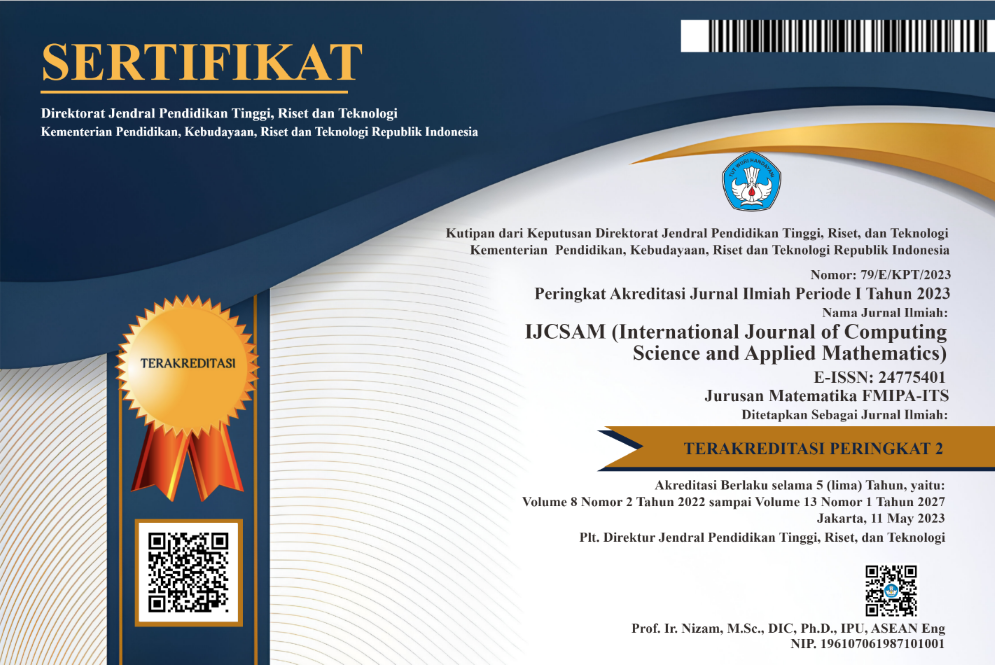Accelerated Numerical Method for Singularly Perturbed Differential Difference Equations
Abstract
Keywords
Full Text:
PDFReferences
A. Longtin and J. Milton, “Complex oscillations in the human pupil light reflex with “mixed” and delayed feedback,” Mathematical Biosciences, vol. 90, no. 1-2, pp. 183–199, 1988.
M. Derstine, H. Gibbs, F. Hopf, and D. Kaplan, “Bifurcation gap in a hybrid optically bistable system,” Physical Review A, vol. 26, no. 6, p. 3720, 1982.
V. Glizer, “Asymptotic analysis and solution of a finite-horizon hinf control problem for singularly-perturbed linear systems with small state delay,” Journal of Optimization Theory and Applications, vol. 117, no. 2, pp. 295–325, 2003.
D. Swamy, K. Phaneendra, A. Babu, and Y. Reddy, “Computational method for singularly perturbed delay differential equations with twin layers or oscillatory behaviour,” Ain Shams Engineering Journal, vol. 6, no. 1, pp. 391–398, 2015.
K. Phaneendra, G. Soujanya, and Y. Reddy, “Numerical solution of second order singularly perturbed differential–difference equation with negative shift,” International Journal of Nonlinear Science, vol. 18, no. 3, pp. 200–209, 2014.
P. Chakravarthy, S. Kumar, and R. Rao, “An exponentially fitted finite difference scheme for a class of singularly perturbed delay differential equations with large delays,” Ain Shams Engineering Journal, vol. 8, no. 4, pp. 663–671, 2017.
L. Sirisha and Y. Reddy, “Numerical solution of singularly perturbed differential-difference equations with dual layer,” American Journal of Applied Mathematics and Statistics, vol. 2, no. 5, pp. 336–343, 2014.
G. Gadisa, G. File, and T. Aga, “Fourth order numerical method for singularly perturbed delay differential equations,” International Journal of Applied Science and Engineering, vol. 15, no. 1, pp. 17–32, 2018.
E. Doolan, J. Miller, and W. Schilders, Uniform numerical methods for problems with initial and boundary layers. Boole Press, 1980.
M. Kadalbajoo and K. Sharma, “Numerical analysis of singularly perturbed delay differential equations with layer behavior,” Applied Mathematics and Computation, vol. 157, no. 1, pp. 11–28, 2004.
H.-G. Roos, M. Stynes, and L. Tobiska, Robust numerical methods for singularly perturbed differential equations: convection-diffusion reaction and flow problems. Springer Science & Business Media, 2008, vol. 24.
G. File, G. Gadisa, T. Aga, and Y. Reddy, “Numerical solution of singularly perturbed delay reaction-diffusion equations with layer or oscillatory behaviour,” American Journal of Numerical Analysis, vol. 5, no. 1, pp. 1–10, 2017.
Z. Li, Z. Qiao, and T. Tang, Numerical solution of differential equations: introduction to finite difference and finite element methods. Cambridge University Press, 2017.
R. Varga, “Matrix iterative analysis. 2000. second revised and expanded edition.”
M. Kadalbajoo and Y. Reddy, “A nonasymptotic method for general linear singular perturbation problems,” Journal of Optimization Theory and Applications, vol. 55, no. 1, pp. 257–269, 1987.
G. Smith, Numerical solution of partial differential equations: finite difference methods. Oxford university press, 1985.
DOI: http://dx.doi.org/10.12962%2Fj24775401.v7i2.6859
Refbacks
- There are currently no refbacks.
View My Stats

International Journal of Computing Science and Applied Mathematics by Pusat Publikasi Ilmiah LPPM, Institut Teknologi Sepuluh Nopember is licensed under a Creative Commons Attribution-ShareAlike 4.0 International License.
Based on a work at https://iptek.its.ac.id/index.php/ijcsam.






